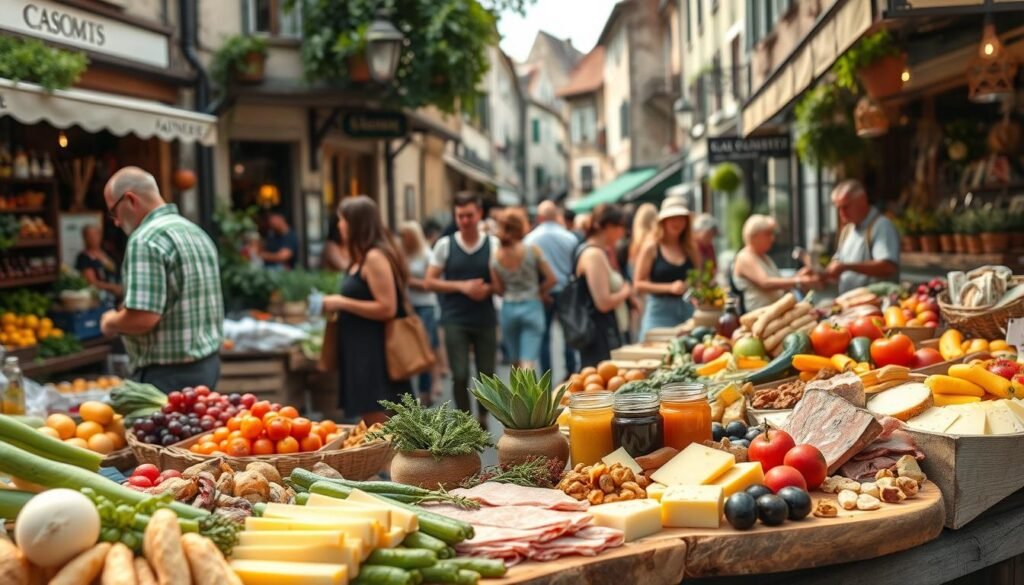Starting a journey to enjoy local food is very rewarding. It lets you connect with the community and its culture deeply. You get to explore the unique flavors and cuisine of a place.
Eating locally is more than just eating food from your area. It’s an experience that lets you enjoy the unique tastes and traditions of a place. By eating locally, you help local farmers and artisans. You also support the local economy and enjoy fresher, tastier food.
As you explore culinary trails, you’ll find hidden spots and famous places. They all show the best of local cuisine. This guide will help you enjoy your local food adventure to the fullest.
Key Takeaways
- Discover the benefits of eating locally and how it supports the local community.
- Learn how to identify and enjoy authentic local food.
- Explore the best practices for navigating culinary trails.
- Understand the importance of supporting local farmers and artisans.
- Find tips on making the most of your local eating experience.
The Benefits of Eating Locally
Choosing to eat locally can greatly benefit your health and the environment. By choosing local food, you get many advantages. These benefits go beyond just your health to include the environment and the economy.
Health Advantages of Fresh, Local Food
Local food is fresher and more nutritious because it doesn’t travel far. This means better taste and higher nutritional value. Eating locally also cuts down on pesticides and preservatives found in long-distance food.
Environmental Impact Reduction
Eating locally cuts down on carbon emissions from food transport. It supports sustainable agriculture. It also helps keep biodiversity by growing many different crops.
Economic Benefits for Your Community
Supporting local farmers boosts the local economy. This support can lead to stronger community development. It also helps keep your area’s agricultural heritage alive.
| Benefits | Description | Impact |
|---|---|---|
| Health Benefits | Fresh, nutritious food | Improved well-being |
| Environmental Benefits | Reduced carbon footprint | Sustainable agriculture |
| Economic Benefits | Support for local farmers | Robust local economy |
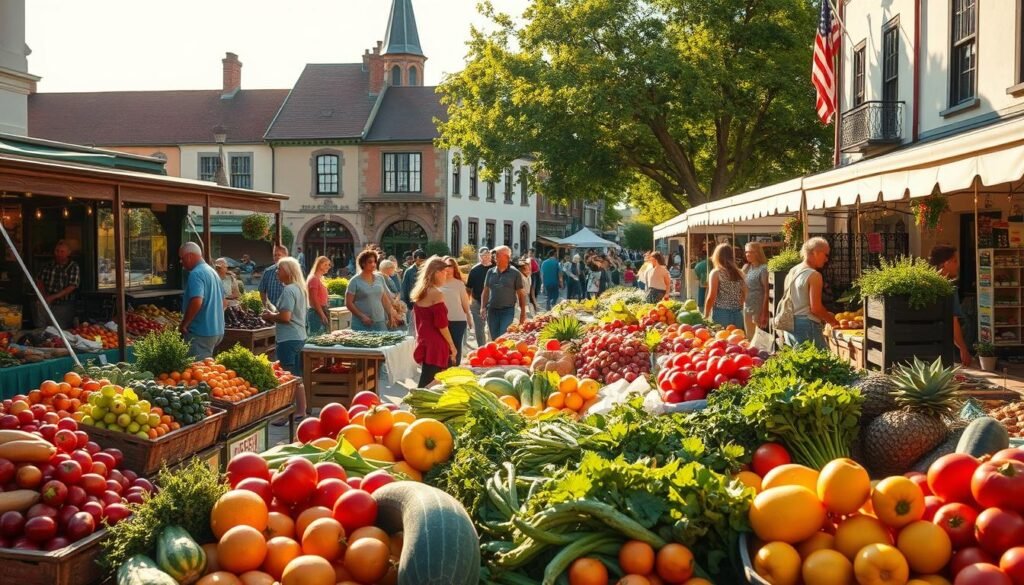
Understanding What “Eating Local” Really Means
“Eating local” means more than just buying food. It’s about supporting your community and the environment. It’s about choosing food grown nearby.
It’s important to know your local food system. This system changes a lot from place to place in the United States.
Defining Local Food in the American Context
In America, “local food” usually means food grown or made close to home. This is often within 100 miles of where you live. But, what it really means can change based on where you are and what people think.
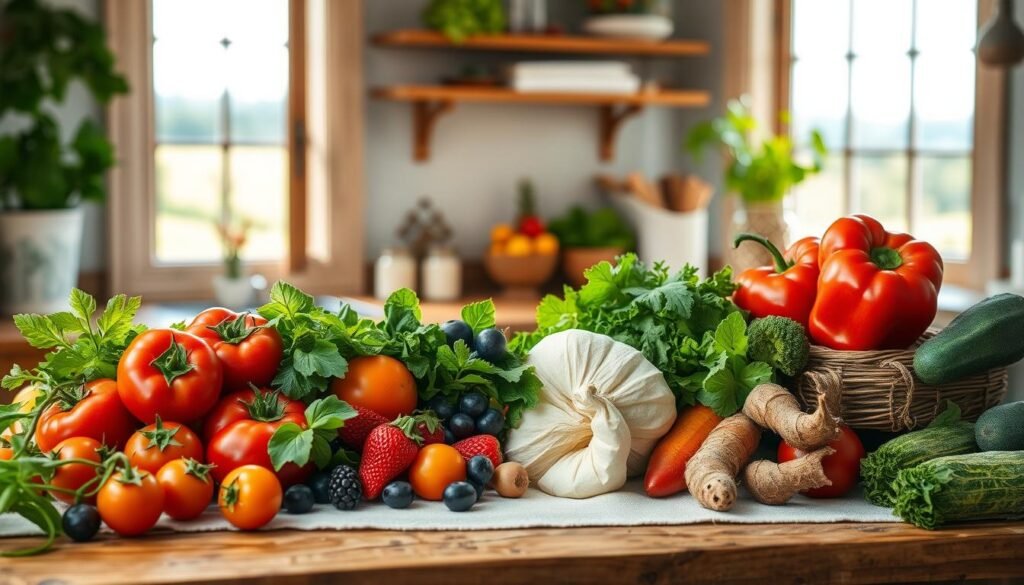
The 100-Mile Diet Concept
The 100-mile diet is a big idea. It tells people to eat food from within 100 miles. This helps keep food tastes fresh and cuts down on pollution from long trips.
Regional Food Identity in the United States
The United States has many different food cultures. These are shaped by history, culture, and where you are. From the sea food of the coast to farm food in the Midwest, each area has its own food story.
Finding Local Food Sources in Your Area
Discovering local food sources is key to a local eating lifestyle. First, you need to know where to look.
Digital Tools for Locating Local Food
Finding local food is now easier thanks to the digital age. Many digital tools help find the best local food sources.
Apps for American Markets
Several apps help Americans find local food. Some top choices are:
- Local Harvest: Finds farmers’ markets, family farms, and locally grown food.
- Farmstand: Allows buying fresh, locally grown produce from farmers.
Online Directories and Resources
There are also online directories and resources for local food. These include:
- USDA’s National Farmers Market Directory: Lists farmers’ markets across the United States.
- Local Food Directories: Online lists of local food sources, like farms and markets.
Community Supported Agriculture (CSA) Programs
CSA programs are a great way to get local food. By joining, you buy a share of a farm’s produce regularly.
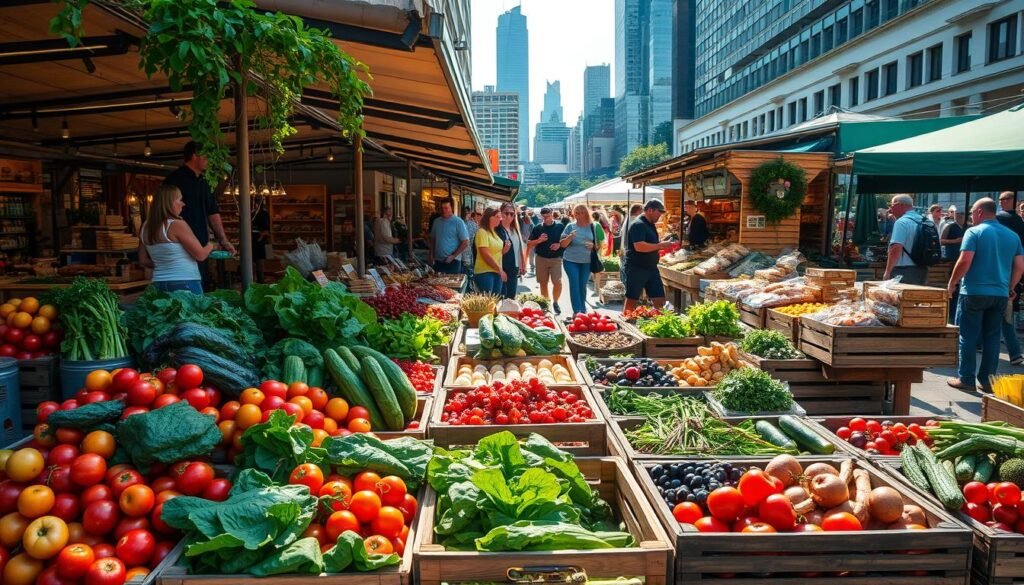
Food Co-ops and Buying Clubs
Food co-ops and buying clubs offer local food at lower prices. They support local farmers and provide fresh produce.
Mastering the Farmers Market Experience
Understanding the farmers market’s rhythms is key. It helps you shop better and connect with producers. You’ll get the freshest produce this way.
Strategic Timing for the Best Selection
Arrive early to get the best produce. Vendors sell out fast. Visit during peak seasons for more variety.
Building Relationships with Vendors
Talking to farmers makes shopping better. Ask about their produce and show interest. You’ll get better service and tips.
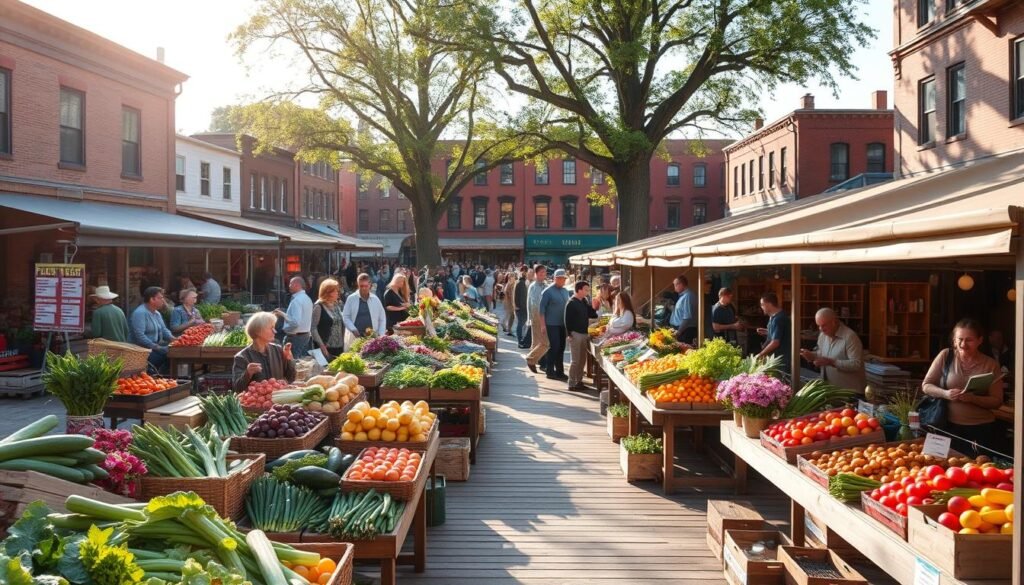
Smart Shopping Techniques and Market Etiquette
Shopping smart means more than just buying. It’s about understanding the market. Use reusable bags and know prices.
Negotiation Tips That Work
Negotiating is easy at the market. Buying in bulk or at the end can save money. Be honest about your budget.
What to Bring and How to Prepare
Being prepared is essential. Bring cash, reusable bags, and a shopping list. It makes your visit more efficient.
| Preparation Tip | Benefit |
|---|---|
| Bring Cash | Many vendors prefer or only accept cash. |
| Reusable Bags | Environmentally friendly and convenient. |
| Shopping List | Helps you stay focused and avoid impulse buys. |
Seasonal Eating: A Key to Local Food Success
Understanding seasonal eating is key to local food success. It lets you enjoy fresher, tastier produce. Plus, it supports local farmers and helps the environment.
Understanding Growing Seasons Across U.S. Regions
Growing seasons change a lot across the U.S. because of different climates. For example, California’s mild winters let farmers grow crops all year. But, northern states like Minnesota have shorter seasons because it’s colder.
Regional Growing Seasons:
| Region | Primary Growing Season | Notable Produce |
|---|---|---|
| California | Year-round | Avocados, tomatoes, leafy greens |
| Northeastern U.S. | Late Spring to Early Fall | Corn, apples, blueberries |
| Southern U.S. | Early Spring to Late Fall | Peaches, okra, sweet potatoes |
Creating Your Seasonal Food Calendar
Make a seasonal food calendar to keep track of local produce. Write down what’s in season each month. Use online tools or talk to local farmers for this info.
“Eating with the season is not just about food; it’s about connecting with the land and the community.” – Unknown
Preserving Methods for Year-Round Local Eating
To enjoy local food all year, try different preservation methods. Canning, freezing, and dehydrating keep seasonal produce fresh.
- Canning: Ideal for fruits, vegetables, and meats
- Freezing: Best for preserving the nutritional value of produce
- Dehydrating: Great for making dried fruits, herbs, and vegetable snacks
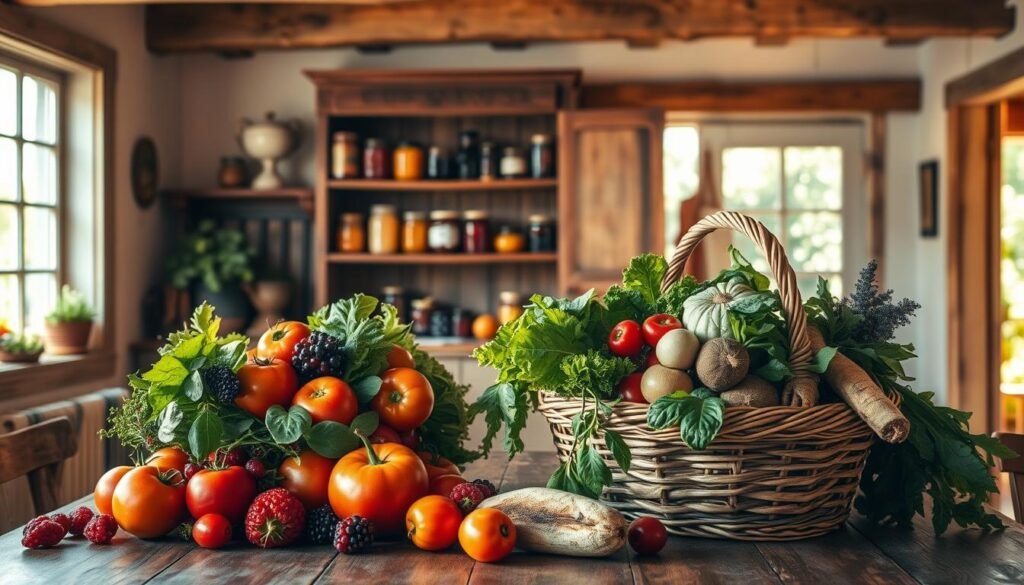
Building Relationships with Local Producers
Connecting with local farmers and producers can make your meals better and help your community. By doing this, you learn more about your food and the hard work behind it.
Finding and Visiting Local Farms
Visiting local farms is a great first step. Many farms have tours or open houses. Here, you can meet farmers and learn about their work. Look for farms that are certified by organizations such as the USDA’s National Organic Program or those that sell at local markets.
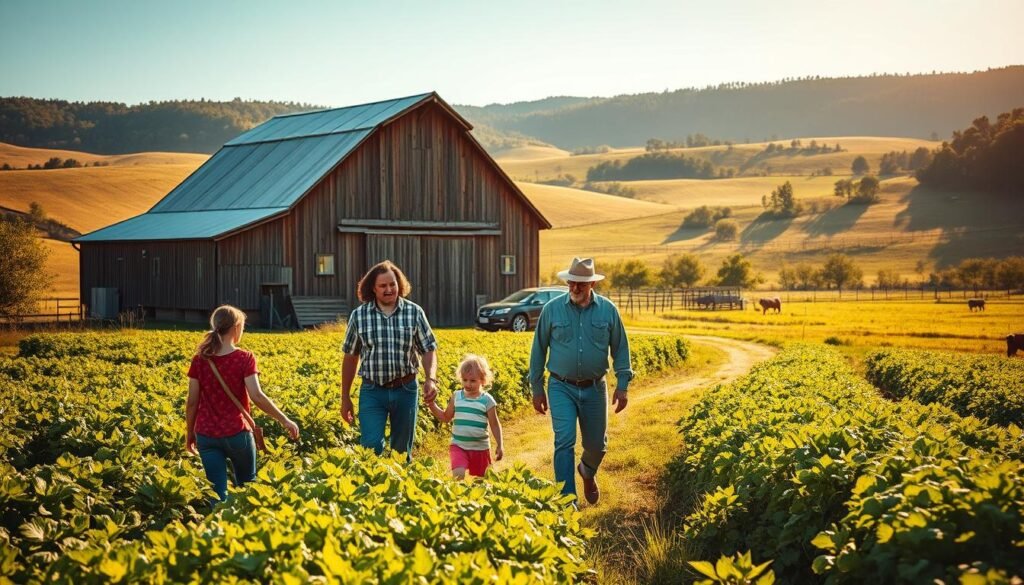
Participating in Farm-to-Table Events
Farm-to-table events are also a good way to meet local producers. These events, held at local restaurants or farms, highlight local food. Be sure to ask questions and engage with the producers to build meaningful relationships.
Volunteer and Work-Share Opportunities
Volunteering or work-sharing at local farms is a hands-on way to connect. You’ll learn about farming and help the local food system. Many farms offer these programs, which are rewarding for those who want to get closer to local food.
Culinary Trails: How to Eat Locally Like a Pro
Exploring America’s culinary trails is an exciting adventure. These trails take you to the best local eateries, farms, and food producers. You get to taste the unique flavors of each region.
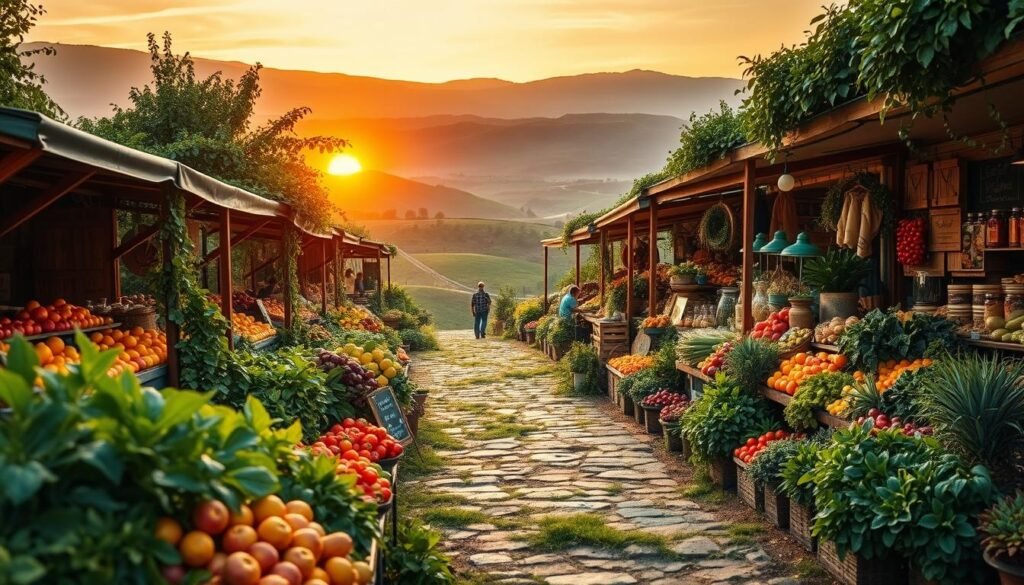
Famous American Food Trails Worth Exploring
The U.S. has many famous food trails. They highlight the country’s rich food cultures. Here are some top ones:
- Northeast Seafood Trails
- Southern Barbecue Routes
- California Wine Country Experiences
Northeast Seafood Trails
The Northeast is known for its fresh seafood. Trails here let you try lobster, clam chowder, and more in coastal towns.
Southern Barbecue Routes
The South is famous for its barbecue. Each region has its own style. A barbecue trail lets you taste these differences.
California Wine Country Experiences
California’s wine country is a dream for wine lovers. Trails here take you to vineyards and wineries for tastings and tours.
Creating Your Own Local Food Adventure
Creating your own food adventure is rewarding. Start by finding local eateries, farms, and producers. Plan a route to visit these spots.
Documenting and Sharing Your Culinary Discoveries
Sharing your food adventures is a great way to keep memories alive. Keep a food journal or blog to share your finds and tips.
Navigating Local Restaurants and Eateries
Finding the best local eateries can be tricky. It’s important to know which places truly support local food systems. This is because more people want to eat at places that use local ingredients.
Identifying Truly Farm-to-Table Establishments
To find real farm-to-table restaurants, look for places that show off their local suppliers. Check for certifications like “Certified Local” or “Farm-to-Table”. Also, ask your server about where the ingredients come from. Places that are open about their sources are usually serious about local food.
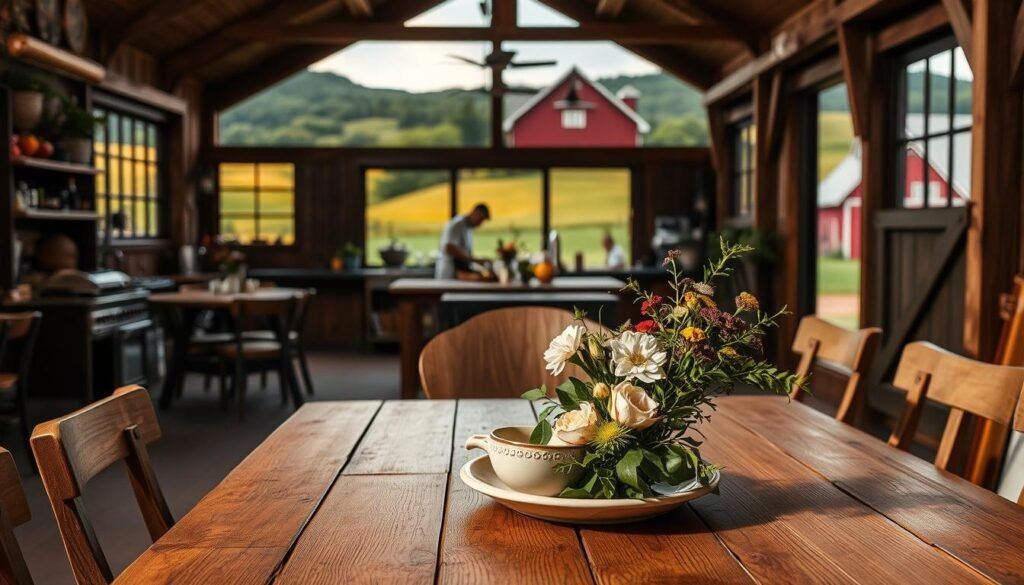
Questions to Ask About Ingredient Sourcing
When you’re out to eat, it’s okay to ask about the food’s origins. You might say, “Is this produce sourced locally?” or “Can you tell me about your meat suppliers?” Good restaurants will be eager to share this info, showing they care about local ingredients.
Supporting Restaurants That Support Local Farmers
Choosing to eat at places that support local farmers helps the local food economy. Look for menu descriptions that mention local ingredients. Also, ask about the restaurant’s ties to local farmers. This support keeps local farming alive and helps the community grow.
Cooking with Local Ingredients
Using local ingredients in your cooking can make your meals taste better and fresher. It also helps support local farmers and is good for the environment.
Adapting Recipes to What’s Available Locally
To use local ingredients well, you need to be flexible with your recipes. You might swap out ingredients for local ones or change how you cook to use the freshest produce. For example, if a recipe calls for a leafy green that’s not in season, you can use what’s at your local farmers market instead.
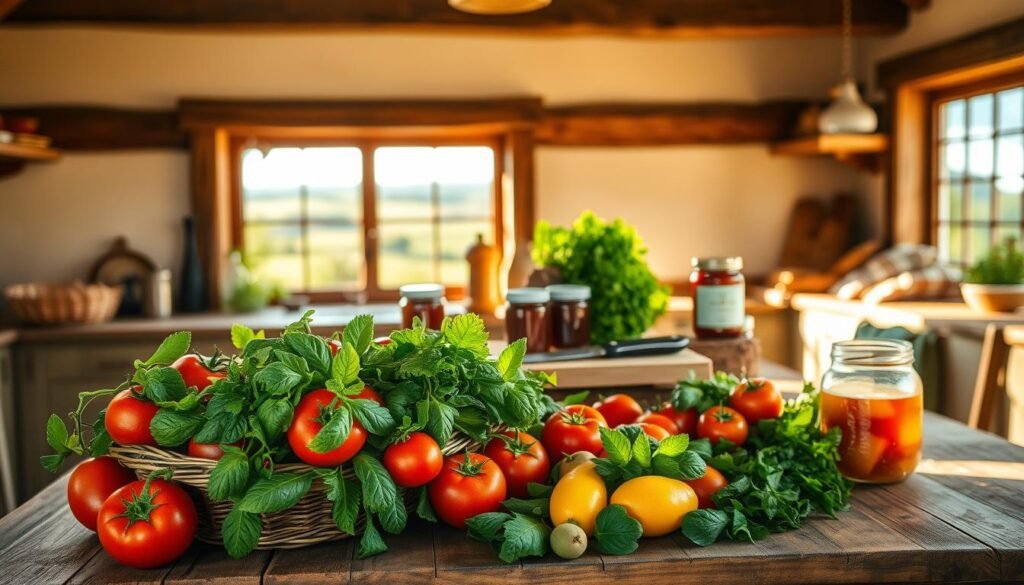
Techniques for Working with Unfamiliar Local Foods
When you’re cooking with foods you don’t know, learning basic cooking techniques is key. Roasting brings out the sweetness in veggies, while grilling adds a smoky taste to meats and fish. Trying different cooking ways can lead to finding new favorite dishes.
- Roasting: Enhances the natural sweetness of vegetables.
- Grilling: Adds a smoky flavor to meats and fish.
- Searing: Creates a crispy exterior while keeping the interior tender.
Regional American Cooking Methods Worth Learning
Regional American cooking has many techniques, like smoking and preserving, and heritage cooking. Knowing these methods helps you use local ingredients well and make dishes that are true to their region.
Smoking and Preserving Techniques
Smoking and preserving are old ways to keep food fresh longer. Smoking uses smoke to preserve food, while preserving uses salt, sugar, or vinegar to stop bacteria from growing.
Heritage Cooking Methods
Heritage cooking methods are passed down through generations, often tied to specific regions or cultures. These methods add depth and authenticity to your cooking, making your dishes truly local.
Key Takeaways:
- Be flexible with your recipes to accommodate local ingredients.
- Experiment with different cooking techniques to enhance flavors.
- Learn regional cooking methods to create authentic dishes.
Eating Locally on a Budget
Eating local on a budget is possible with strategic shopping, choosing wisely, and using smart preservation methods. These steps help you enjoy fresh, local food without breaking the bank.
Strategic Shopping for Maximum Value
Shopping smart is key to saving money on local food. Visit farmers’ markets late in the day for discounts. Also, consider joining a CSA program for a season’s produce at a lower cost.
Prioritizing Your Local Food Purchases
Focus your spending on essentials like grains, beans, and root vegetables. They’re often cheaper and locally available. Plan meals around what’s in season to save money.
Bulk Buying and Preservation Methods
Buying in bulk and preserving food saves money. Methods like freezing, canning, and fermenting let you enjoy local food all year.
Freezing Techniques for Different Foods
Freezing is easy and preserves many foods. Blanching veggies keeps their color and nutrients. For fruits, lemon juice prevents browning.
Canning and Fermenting Basics
Canning heats food to kill bacteria, then seals it in jars. Fermenting uses good bacteria to preserve food, boosting its nutrition and taste. Both need practice but save money and provide access to local foods all year.
Overcoming Challenges of Local Eating
Local eating comes with its own set of challenges. These include seasonal changes and how easy it is to get food. One big issue is the limited availability of fresh produce during certain times.
Dealing with Seasonal Limitations
To beat seasonal limits, try preservation techniques like canning, freezing, or dehydrating. This way, you can enjoy local foods all year.
Balancing Local Ideals with Practical Realities
It’s tough to balance wanting to eat locally with what’s practical. You can get around this by being flexible. Just be open to substituting ingredients with what’s in season.
Addressing Food Access Issues
Some areas face big challenges in getting food. To help, support local efforts like community gardens or food cooperatives. They can make a big difference.
| Challenge | Solution |
|---|---|
| Seasonal Limitations | Preservation Techniques |
| Practical Realities | Flexible Ingredient Substitution |
| Food Access Issues | Community Gardens & Food Cooperatives |
Conclusion
Eating locally is more than just food; it’s a journey that connects you to your community and the environment. It also enhances your taste. By learning about local food, visiting farmers markets, and cooking with fresh ingredients, you become a true local food lover.
Your culinary adventure is just starting. Keep exploring the unique tastes and stories of your area. Visit farms, join farm-to-table events, and eat at places that use local ingredients. Every step you take makes your food journey more sustainable and tasty.
Remember, the journey of local food is as valuable as the food itself. Enjoy the flavors, the effort put into making your meals, and the company of those who create your food. Your local food journey is a path to new discoveries, connections, and amazing meals.

